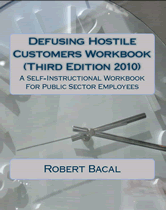
The Exit Interview - MiniGuide For Managers
The exit interview is a critical tool for both organization improvement, and management development. If organizations are to improve they need to know why an employee is leaving, and his or her perceptions about the organization. A manager also needs this feedback, because the one essential piece to management development is knowledge about how one is perceived by one's employees.
What Is An Exit Interview?
An exit interview is a process where an employee who is leaving a specific organization is given the opportunity to discuss their stay with the organization, and their perceptions about the organization and the manager. Regardless of whether an employee is layed off, dismissed, takes early retirement, transfers or resigns, that employee is a valuable source of information.
There are a number of ways to conduct such a process. We recommend two interviews. The first interview can take place between the immediate supervisor/manager and the employee. The second interview should take place between the employee and his or her boss's boss. The purpose of the first interview is to provide feedback and information to the immediate supervisor. The second interview helps to provide the higher level manager or executive with a better understanding of the subordinate organization, so that issues may be identified and flagged for improvement.
Taking Comments In Context
Not all comments made during any individual exit interview will be accurate, or useful, particularly if the employee is leaving under unpleasant circumstances. Some comments can be downright nasty. The important point is to look at patterns of responses that occur across exiting employees, and occur over time. By looking at patterns, it is possible to separate comments that are only motivated by an individual employee's anger, from the comments that we need to use to improve.
If a single employee makes some negative comments about the organization or a manager, we don't know whether we should treat the comments as a "red-flag" that there is a real problem. If however, several exiting employees make similar comments over a period of a year or two, that lends more credence to those comments.
So, the information gathered must be placed within a larger context. That is not to say that individual employee comments should be ignored, but that the payoff for managers and the organization is in looking at the patterns. When patterns re-occur, then it is necessary to look more closely at the issues.
Scary Stuff
Now, if you are a manager out there, you might be shaking your head and saying "Good Lord, I don't want to sit and listen to the abuse of an angry employee, and I certainly don't want MY boss to hear all those negative comments". And that's understandable.
Well, it might not be pleasant. Or you might be pleasantly surprised. The basic issue, however, is how much you value the information that you might obtain, weighing the benefits of that information against your discomfort with the risk of initiating such an interview. It can feel threatening, but the information you receive may be unattainable in any other way. That's a decision only you can make. However, if you choose to do exit interviews we will give you some tips.
Exit Interview Tips
1. Make exit interviews a standard procedure. Either make the commitment to do them with all exiting staff or don't bother. If you only do them sometimes, your information will be skewed, and you will be unable to accurately identify patterns or problems.
2. Offer the opportunity to exiting staff, but don't insist. Indicate that you value their ideas, but if they choose not to enter into the process, respect that choice. You can't force this cooperation.
3. Schedule the interview sometime towards the end of employment if that's possible. The last week is good. Also set a time limit to the process. A half- hour should be adequate. By setting a time limit, you can get down to business, and if the process is unpleasant, you can gracefully end the process as the time expires.
4. Structure the interview. As with any interview, plan your questions in advance. Consider developing a set of standard questions that you can re-use.
5. Listen and don't defend or argue. There is little point in trying to defend yourself or the organization, and such behaviour only tells the employee that you aren't REALLY interested in their perceptions. Remember, you are gathering information, not trying to persuade or argue.
6. Approach the employee by explaining the purpose of the interview. Indicate how you will use the information, and any issues of confidentiality that are important. When scheduling the interview with the exiting employee, it isn't a bad idea to give a written copy of the questions you will be asking, so that he or she can be prepared, and feel more comfortable.
7. Be prepared to use gentle follow-up questions if the employee is not being specific enough, or forthcoming.
Some Questions To Try
We can suggest some questions to ask. Note that the tone is one of improvement rather than blame, and manager responsibility. You probably won't want to use all of these, and you may have some of your own to add.
1. What did you enjoy most about working here?
2. What did you find the most difficult part of working here?
3. Is there anything we could have done to have encouraged you to stay with us (when employee resigns)?
4. Do you feel you got what you needed to do your job effectively?
5. Is there anything you think I could have done differently to help you do your job more effectively?
6. What will you miss the most?
7. What will you miss the least?
8. How do you think we could have made this a better place to work?
Conclusion
The exit interview can give you information that you can't get in any other way. It also can be threatening and uncomfortable. You need to make the judgement as to whether you can tolerate the risk, and whether you can listen to exiting comments without arguing or become defensive. However, you will find that these comments can help you improve as a manager, and help you identify and overcome barriers to improving your organization.





